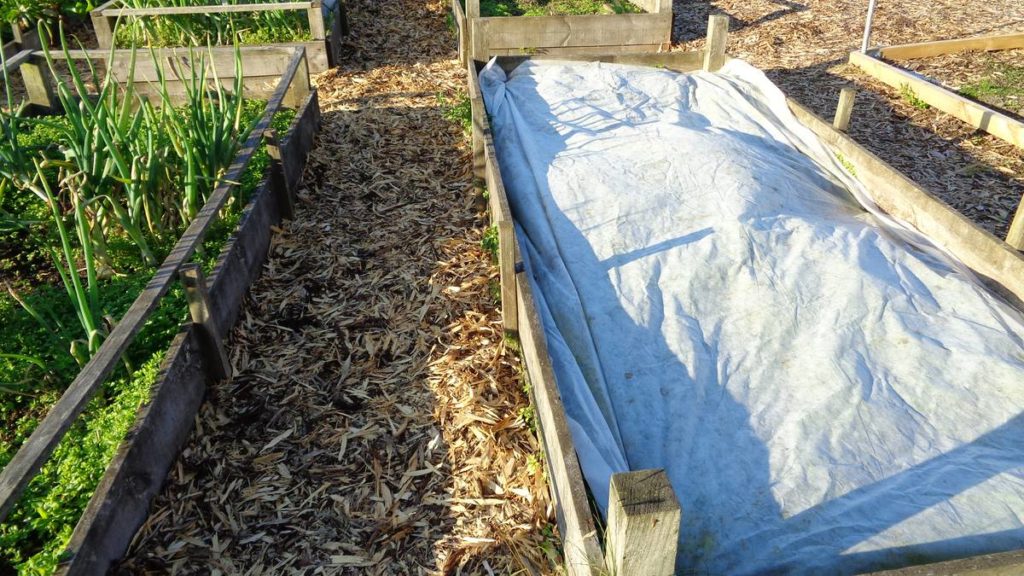There are two sorts of paths on allotments and in gardens. The permanent paths, like a path between plots and temporary paths laid to divide growing areas that may well be moved after a year or so. This question came in about using gravel paths for those temporary paths that I found interesting.
I was wondering whether you could give advice about using pea gravel over plastic (i.e. waterproof) weed membrane for minor paths (i.e. paths between beds) on my allotment. The major paths without gravel will go on the main paths which are kept bare. None of the pathways connected to neighbouring gardens will have pea gravel put on them to avoid spillage into their garden.
There is nothing in our Tenancy Rules stating that we aren’t allowed to use gravel. I chose pea as opposed to decorative gravel purposefully, because it’s naturally sourced and is small enough so it can be safely incorporated into the soil without causing harm.
Thank you for taking time to read this email, and if you are able to help, I’d very much like your opinion.
Best wishes
George
Let me start by saying I really like gravel paths and drives in formal gardens. Very Downton! But I’m not so sure about gravel for allotment paths.
Weed Fabric or Membrane
To start at the bottom; weed membrane or landscape fabric does allow water through which is a good thing. Good quality membranes will stop weeds coming up from the soil below but weeds and grass particularly growing from above can actually root into it. Removing those weeds is difficult and matted grass roots may well damage the membrane when pulled out.
If the plot is left untended and weedy, that matting can be as difficult to remove as carpet, which many sites have banned for that reason. Too often people start with the best of intentions and then leave the site and their creations for others to cope with. That weed membrane is likely to have broken up after a few years, adding an unwelcome material to the soil.
Edging
The gravel path will need edging of some type (usually wooden planks) to hold it in place or it will creep to the sides quite quickly.
Maintenance
Gravel paths are high-maintenance. Bits of soil are dropped and scraped off boots onto it which gives weeds something to grow in. Some weeds will grow in pure gravel anyway. Over the years the amount of soil in the gravel increases and the task of keeping it looking good and weed free becomes more difficult and time consuming.
Of course you can spray with a weed-killer but do you really want to be using them? Personally I think they have their place as a last resort but are best avoided if possible.
Relocating the Path
Finally, if the path has to be moved for any reason, it’s not that easy getting the gravel up again. Gravel, within reason, is generally not a real problem in growing soil. In fact gravel may help with drainage in a clay soil, but something to consider.
Conclusion – Woodchips are Best
So, for the above reasons, I wouldn’t use gravel for the minor paths myself. I like woodchips laid thickly directly onto the soil. They rot down over time and can be just dug into the soil, adding to the humus. They encourage fungal growth in the soil as well which has some benefit.





Hi, I did a fair amount of research and decided that because I didn’t want any hard landscaping on my allotment I went with the cardboard lined paths with wood chip over the top. It’s held up well so far. All resourced for free. As I’m only just coming up to 12 months at my plot I figured it will be very easy to rearrange the layout should I decide I haven’t got it right. Just started to harvest a few things radish, broad beans, including cut flowers Sweet Williams and Sweet Peas. Sadly my over wintered onions are bolting but I think its because of the fluctuating temperature and lack of rainfall.
After lots of tries we now use old carpets for permanent paths: this started because I have epilepsy and contact with the ground would cause less damaged (to me). It costs nothing, lasts for years and is easy to replace. for paths between plants we use the plastic squares that have become available over recent years, They are 1′ square and clip together, so it is easy to make the paths ‘wander-which helps with rotation. The weeds that poke through can be decapitated easily with the hoe.
Hi
The trouble with using gravel for paths is that when the ground is wet ,every time you move around your plot you will find the gravel sticks to your boots and gets transferred around the plot and mud gets mixed up with your gravel on the path.